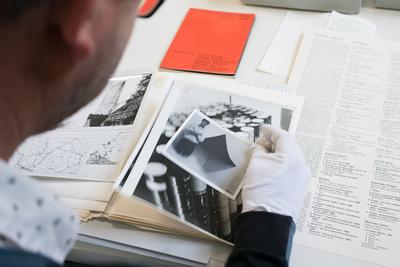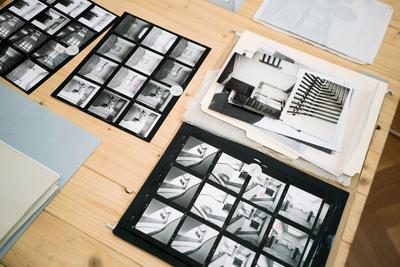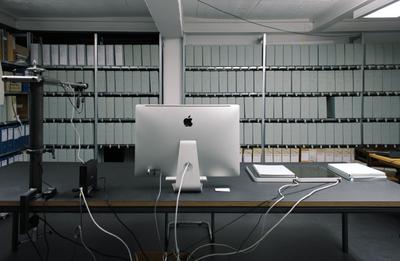Archives
Archives
The physical archive of Kunsthalle Bern is located in the historical building on Helvetiaplatz 1. The archive reflects a century of exhibition-making that fundamentally shaped the development of Western contemporary art and is therefore an important source for twentieth-century exhibition history. The documents in the archive make it possible to reconstruct and retrace the production of exhibitions in Kunsthalle Bern and reveal the involvement of key actors in Europe and beyond, as well as the discourse that shaped Western contemporaneity in the visual arts.
The physical archive is open by appointment.
For information, enquiries and appointments as well as reproduction requests, please contact the archive department and Julia Jost.
The Online Archive of Kunsthalle Bern can be accessed through the website archiv.kunsthalle-bern.ch. Find out more about the Online Archive below.
The Oral Histories is a new chapter in our Archive that is conceived for 2026 onwards as a tool of collecting experiences of visitors to Kunsthalle Bern from the last 70 years, with the aim of producing and collecting new forms of knowledge about the history of Kunsthalle Bern.
Archive Collections
The physical archive contains over 200'000 documents in seven collections: correspondence (from 1933), photos, videos, catalogues, ephemera, posters, press and partial inventory of the association.
The poster collection is held at the Swiss National Library's Prints and Drawings Department.
In the course of celebrating the 100th anniversary of Kunsthalle Bern in 2018, we have begun to preserve, catalogue and make these extensive holdings digitally accessible step by step. The individual holdings are currently in various stages of processing.
For reproduction requests and information on the collection's categories and their content as well as for appointments, please contact the archive department and Julia Jost.
Kunsthalle Bern extends its gratitude to Kultur Stadt Bern, Burgergemeinde Bern, Swisslos Kultur Kanton Bern, UBS Kulturstiftung, Jubiläumsstiftung der Mobiliar, Sophie und Karl Binding Stiftung, Ursula Wirz Stiftung, mmBE Akzent, and Gesellschaft zu Mittellöwen, as well as Memoriav for their support in the processing and digitization of the Archive and the Bern University of the Arts (HKB) for collaborating with us.


Online Archive

The online archive is a project formulated for the centennial of Kunsthalle Bern. Since 2018, we offer audiences a new way of interacting with our archive through an online platform that is formulated by creating research threads and content visible to the user. The project is conceived as a connecting thread, whereby users of the physical archive digitize the materials they handle, allowing a more comprehensive access to information than was possible in the past, while also offering different perspectives on the process of archiving
The online archive is a project formulated for the centennial of Kunsthalle Bern. Since 2018, we offer audiences a new way of interacting with our archive through an online platform that is formulated by creating research threads and content visible to the user. The project is conceived as a connecting thread, whereby users of the physical archive digitize the materials they handle, allowing a more comprehensive access to information than was possible in the past, while also offering different perspectives on the process of archiving.
The Online Archive of Kunsthalle Bern can be accessed through the website archiv.kunsthalle-bern.ch.
The cataloging and conservation of an archive raises countless questions, not least that of digitization. Since a complete digitization from A-Z is enormously time-consuming and costly, and in our case not necessary for conservation reasons, we found an unconventional approach in collaboration with Astrom/Zimmer & Tereszkiewicz and implemented a solution specially developed for the Kunsthalle Bern to digitize a selection of the documents:
The researchers who use the archive make the selection based on their research interests and the digital copies are created together with them through their use of the documents. In this way, research interests and content-related connections of reception can become visible.
In concrete terms, this means that the dossiers are fitted with RFID chips during the cataloguing process and a worktable produced for the Kunsthalle Bern allows researchers to create digital images of individual documents at the click of a mouse. Thanks to the RFID chips, the images are linked to their respective physical folders and stored accordingly in the database. The researchers use a computer interface to add the necessary metadata. In this way, they are provided with a tool that allows them to consistently document and easily create reference materials while simultaneously populating the digital archive and gradually opening it up to external users.
As the digital archive grows, the documents can be placed in a narrative context with inbuilt links to other documents in the collection. Threads thus run through the archive, overlapping and making connections visible that would otherwise remain hidden. This tool can be understood as a device recording the use of the Kunsthalle Bern archive.
This project is both an experiment and a working tool. We are developing it further in close collaboration with archivists, consultants and researchers and with the generous support of Kultur Stadt Bern, Swisslos Kultur Kanton Bern, Burgergemeinde Bern, UBS Kulturstiftung, Jubiläumsstiftung der Mobiliar, Sophie und Karl Binding Stiftung, Memoriav, Ursula Wirz Stiftung, mmBE Akzent and Gesellschaft zu Mittellöwen.
Oral Histories
Coming soon – this part is still fermenting.